The avian world is full of architectural marvels, but few are as impressive as the gravity-defying nests constructed by certain songbirds. Among these master builders, the pendulous nests of the Baya Weaver (Ploceus philippinus) stand out as extraordinary feats of natural engineering. Dangling precariously from branch tips, these elaborate structures seem to defy the very laws of physics, swinging in the breeze yet remaining securely anchored. The remarkable craftsmanship and sophisticated design principles employed by these small birds have fascinated ornithologists and engineers alike. This exploration into the world of these aerial architects reveals not just the incredible technical skills of these feathered builders, but also the evolutionary advantages their suspended homes provide in a world full of predators and environmental challenges.
The Master Architect: Introducing the Baya Weaver
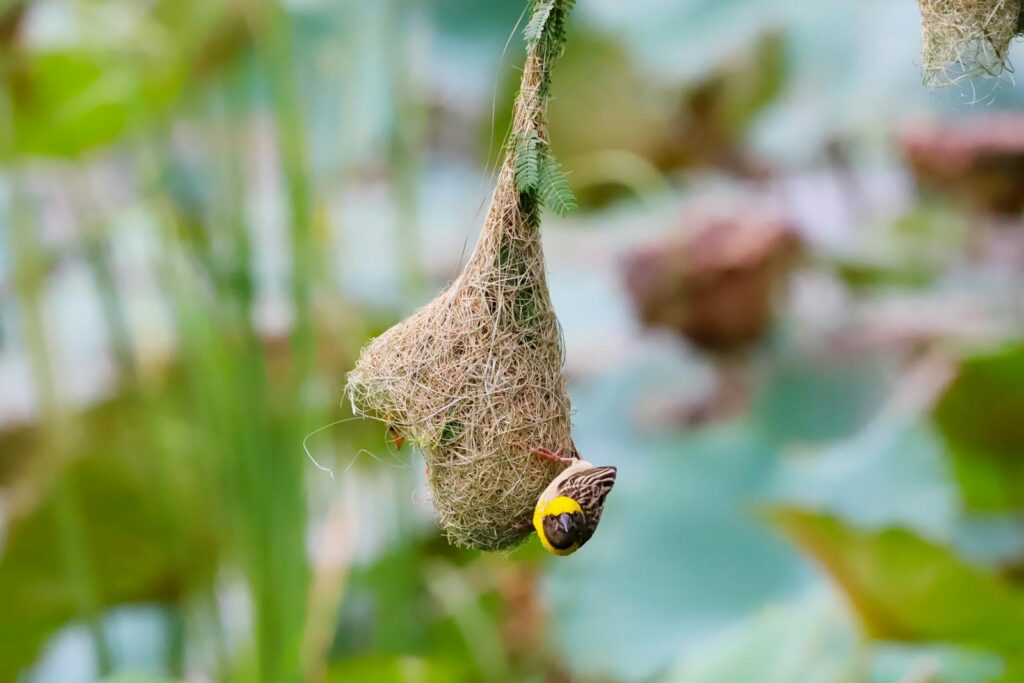
The Baya Weaver, native to South and Southeast Asia, stands out among avian architects for its exceptional nest-building capabilities. Males of this sparrow-sized species feature bright yellow plumage during breeding season, creating a striking contrast against their intricate hanging nests. Weighing just 15-22 grams, these diminutive birds possess no specialized anatomy for construction, relying instead on their ordinary beaks and feet to weave complex structures that can withstand monsoon winds and predator attacks. The Baya Weaver belongs to the family Ploceidae, commonly known as weaver birds, whose members are renowned for their nest-building prowess, though the Baya’s pendulous nests are among the most sophisticated in the family.
The Physics-Defying Design
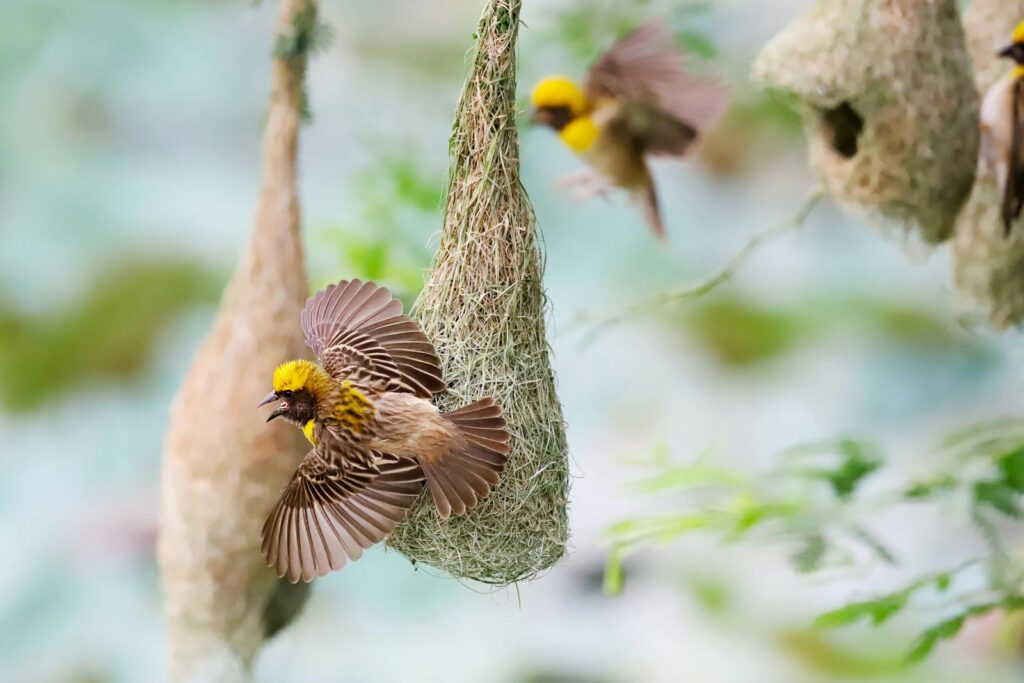
The pendulous nest of the Baya Weaver seems to challenge basic principles of gravity with its inverted flask-like shape suspended from the thinnest branches of trees or palm fronds. The structure begins with a strong attachment point where the bird carefully weaves plant fibers around the supporting branch, creating a suspension system that distributes weight evenly. From this foundation, the nest expands downward into a teardrop or flask shape with walls approximately 1-1.5 cm thick, sufficiently robust to support multiple birds yet flexible enough to move with the wind rather than break against it. The entrance faces downward and often features a long, tubular passageway that prevents predators from reaching inside, creating what engineers would recognize as a sophisticated cantilever design that maximizes strength while minimizing material usage.
Construction Materials and Techniques
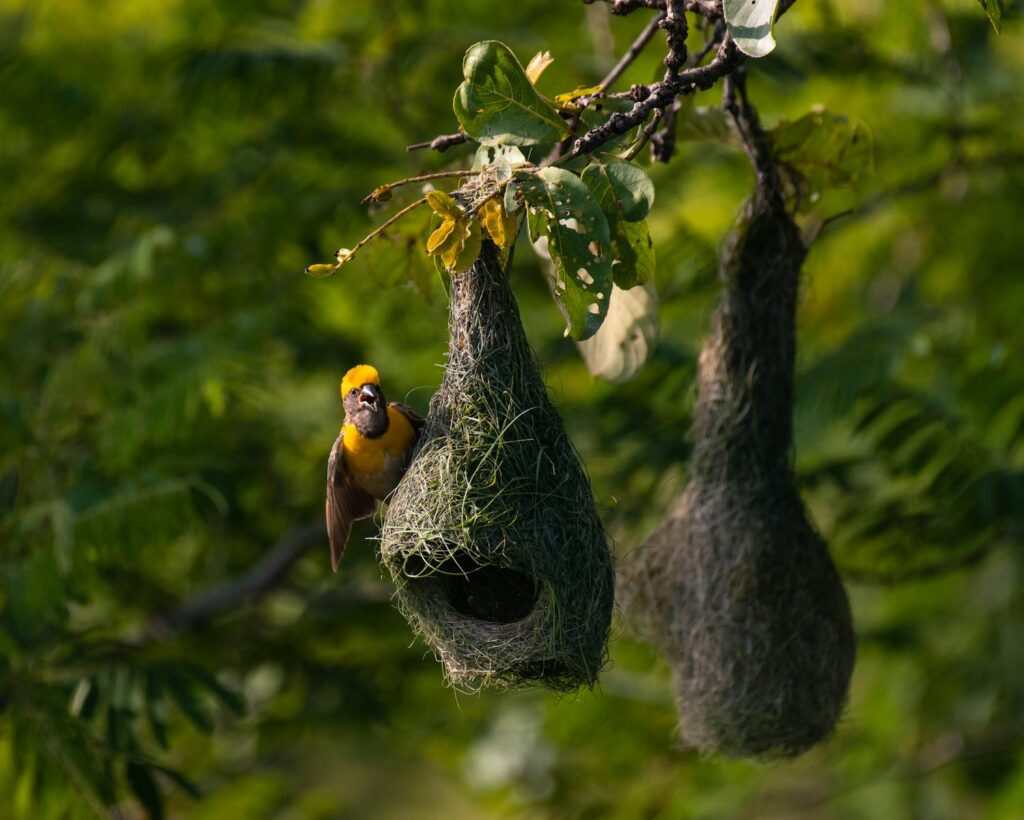
Baya Weavers demonstrate remarkable selectivity in their choice of building materials, predominantly using long, flexible plant fibers stripped from palm leaves, grass blades, and similar vegetation. Each bird meticulously harvests hundreds of individual strands, sometimes traveling considerable distances to collect specific materials with the right tensile properties. The construction process begins with the male weaving a strong anchor rope around the supporting branch, followed by the creation of a ring that will form the nest entrance. Using a combination of knots, loops, and interlacing techniques, the bird progressively builds outward and downward, carefully threading each new fiber through existing structures and securing it with specialized knots that would impress human sailors. Scientific analysis has identified more than eight distinct weaving patterns used by these birds, creating a textile-like structure with remarkable tensile strength.
The Multi-Stage Building Process
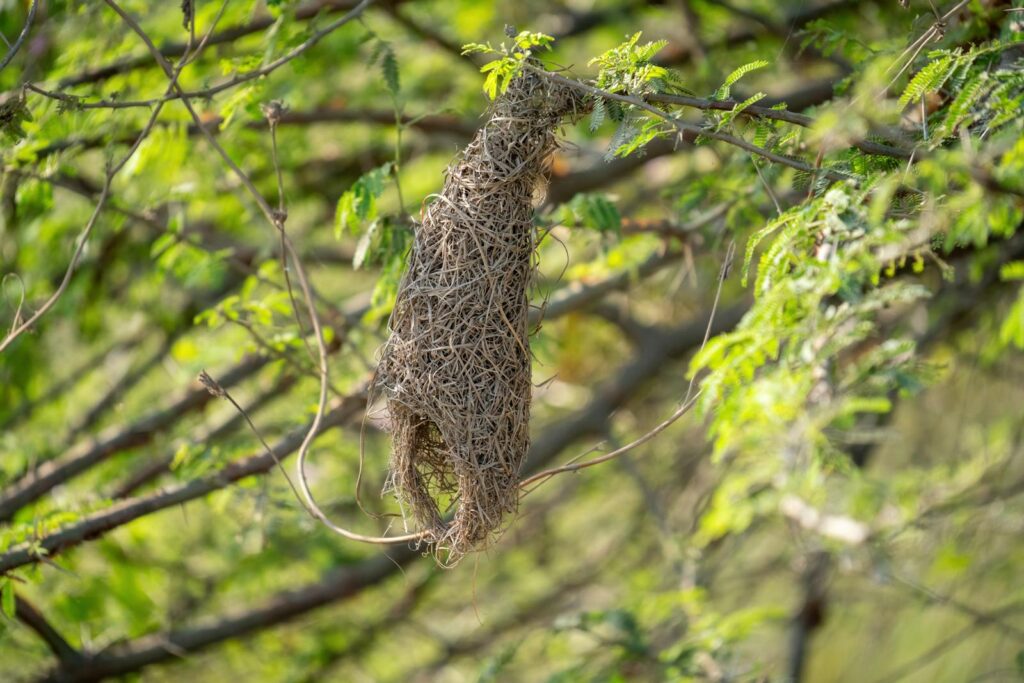
The construction of a Baya Weaver’s nest follows a methodical, multi-phase process that can span two to three weeks of intensive labor. The male bird begins by establishing the critical attachment point, spending up to three days creating a secure foundation before proceeding to form the characteristic entrance ring. The next stage involves expanding the structure downward to create the breeding chamber, with the male working up to 500 hours on a single nest, meticulously placing each strand of grass or fiber. Interestingly, the male builds the nest only to a half-completed stage before attracting a female, who then inspects his craftsmanship thoroughly before deciding whether to accept him as a mate. If she approves, they finish the construction together, with the female focusing on the interior lining using softer materials like feathers, cotton, and fine grass.
Evolutionary Advantages of Hanging Homes
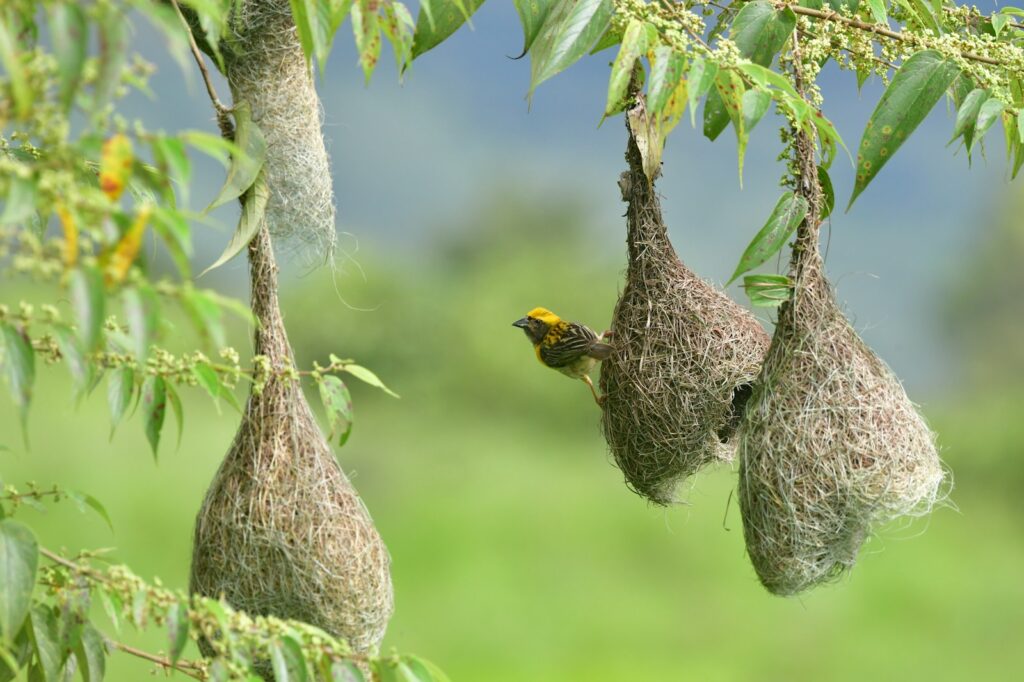
The pendulous design of Baya Weaver nests represents a remarkable evolutionary adaptation that provides multiple survival advantages. By hanging from the tips of branches or palm fronds, often above water, these nests are virtually inaccessible to many predators such as snakes, monkeys, and larger birds that cannot navigate the thin, terminal branches. The downward-facing entrance with its narrow tube creates an additional defensive feature, forcing potential predators to climb upside-down through a constricted passage. During monsoon seasons, the teardrop shape effectively sheds water, while the structure’s flexibility allows it to move with strong winds rather than break. The enclosed design also creates a microclimate within the nest that helps regulate temperature and humidity, protecting eggs and nestlings from environmental extremes that might otherwise prove fatal.
Social Dynamics and Nest Functions
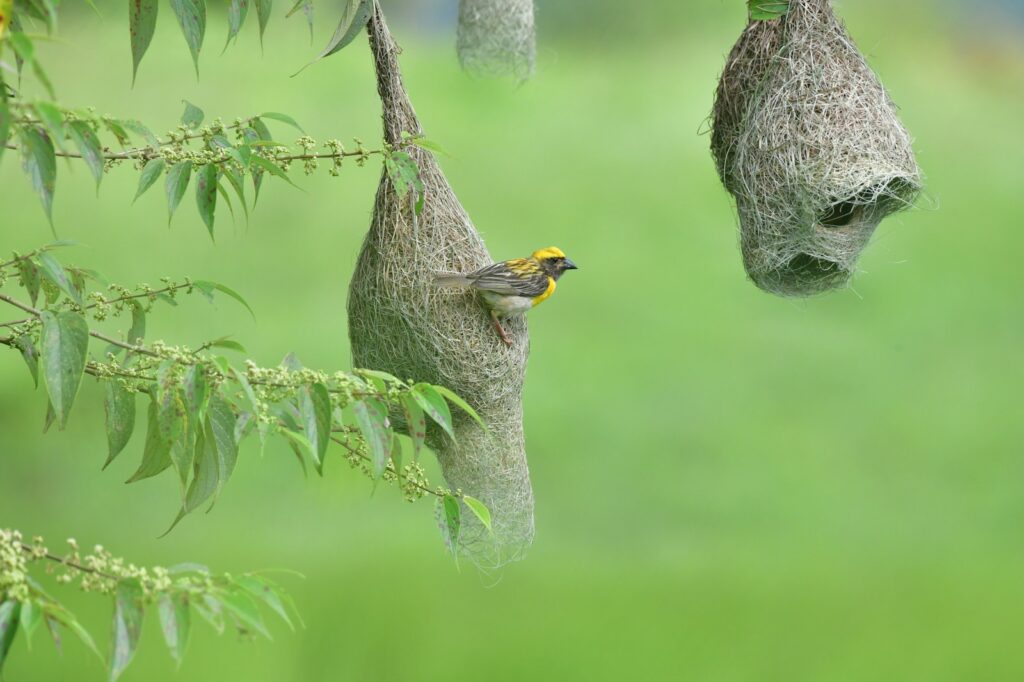
The nest-building behavior of Baya Weavers is deeply intertwined with their complex social dynamics and reproductive strategies. Males typically construct multiple nests in close proximity, creating small colonies that can contain anywhere from five to thirty nests, each representing a significant investment of time and energy. These structures serve not merely as shelters but as crucial display elements in the male’s courtship ritual, with females selecting mates largely based on nest quality and craftsmanship. Intriguingly, not all nests serve breeding purposes; males often build “dummy nests” that function as nighttime roosting spots or decoys to confuse predators. The colonial nesting pattern creates a community surveillance system where multiple birds can alert each other to approaching dangers, significantly enhancing nestling survival rates compared to solitary nesting species.
Architectural Variations Across Regions
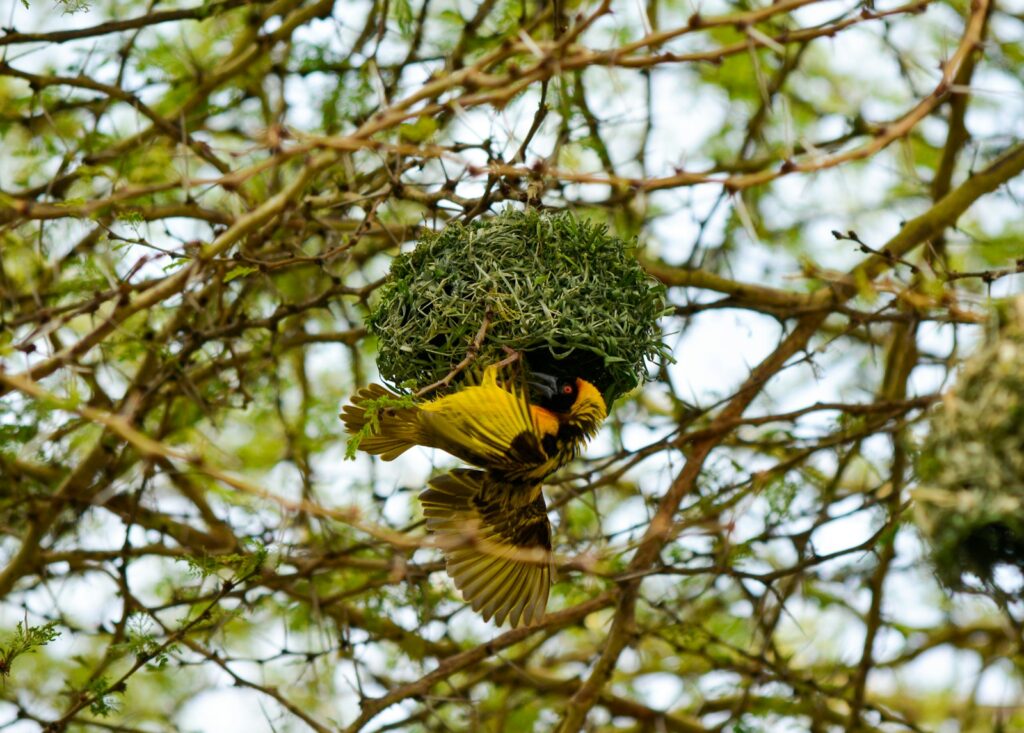
Baya Weavers across their extensive range demonstrate fascinating regional variations in nest architecture, reflecting adaptations to local environmental conditions and available materials. In the more humid regions of southern India and Sri Lanka, nests typically feature longer entrance tubes that provide enhanced protection against driving monsoon rains. Conversely, in the drier northwestern regions, nests often have shorter entrances but thicker walls that offer better insulation against temperature extremes. The attachment mechanisms also vary, with birds in areas frequented by egg-eating snakes favoring smoother, more slippery support branches and incorporating specialized anti-predator features like narrower entrance tunnels with sharp bends. These variations showcase the species’ remarkable behavioral plasticity and ability to modify their architectural approach in response to local ecological challenges.
The Engineering Marvels of Nest Structure
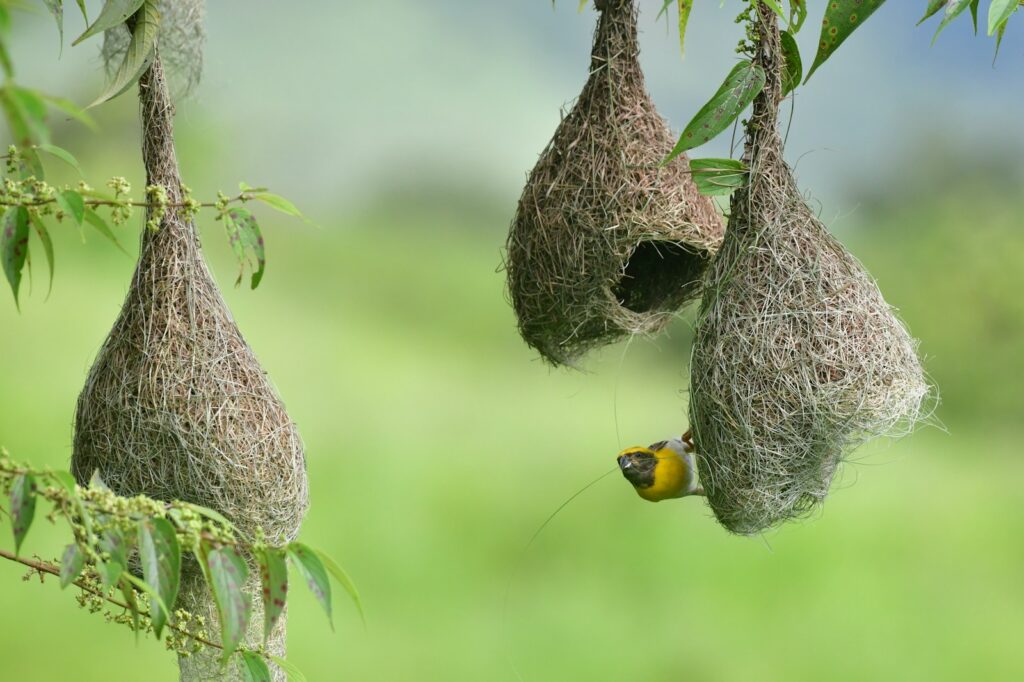
From an engineering perspective, the Baya Weaver’s nest represents a remarkably sophisticated structure that embodies principles of tensile architecture. Biomechanical studies have revealed that these nests utilize an efficient distribution of forces through their woven lattice, creating a structure that maintains integrity while using minimal material. The nest’s tear-drop shape, with its wider bottom chamber, creates a low center of gravity that enhances stability during winds. When examined microscopically, the weaving pattern reveals a non-random organization that maximizes strength at critical junctures, particularly at the attachment point and entrance tunnel. The birds instinctively incorporate redundant support systems, ensuring that if one section fails, the overall structural integrity remains intact, much like the safety systems in modern engineering designs.
Intelligence Behind the Architecture
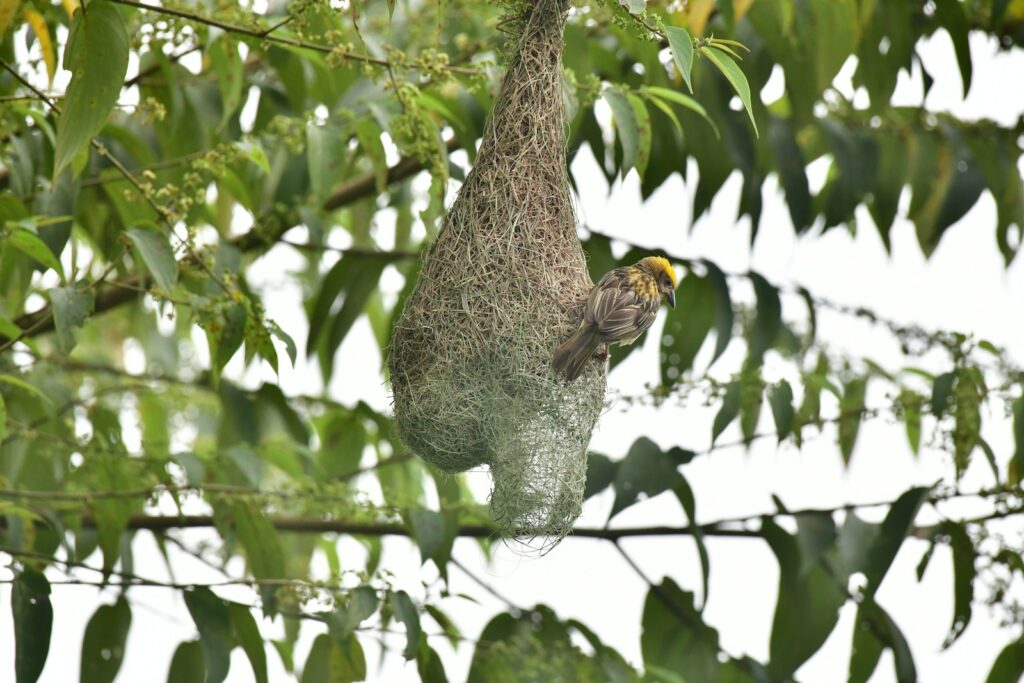
The sophisticated construction abilities of Baya Weavers raise fascinating questions about avian cognition and the nature of instinctive versus learned behaviors. While the basic nest-building blueprint appears to be genetically programmed, individual birds show remarkable problem-solving abilities when facing construction challenges, suggesting significant cognitive flexibility. Young males practice nest-building skills before reaching maturity, progressively improving their technique through what appears to be a combination of observation and trial-and-error learning. Experimental studies have demonstrated that weavers can adapt their building techniques when presented with novel materials or when their typical materials are artificially weakened, indicating an understanding of structural properties beyond simple instinctual programming. This blend of innate knowledge and adaptive learning represents a sophisticated cognitive system packed into a brain weighing less than a gram.
Cultural Significance and Human Connections
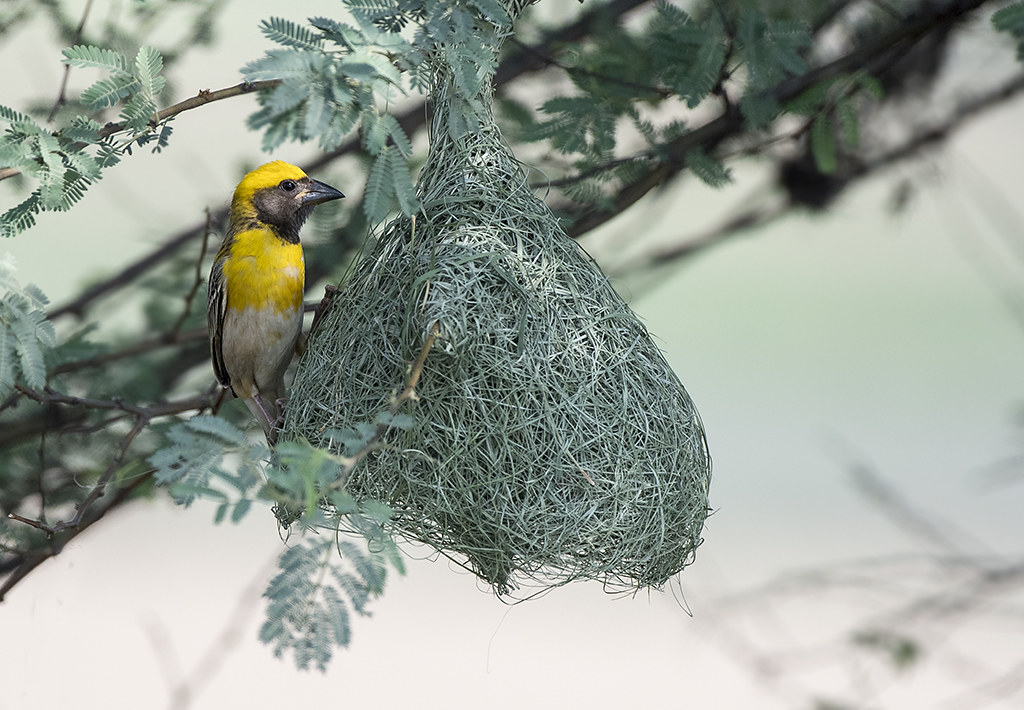
The remarkable nests of Baya Weavers have earned them a special place in the cultural traditions and folklore of many South Asian societies. In parts of India, these birds are considered symbols of diligence and craftsmanship, with their nests often preserved as decorative items or good luck charms. Traditional stories in rural communities frequently feature these birds as characters representing industriousness and attention to detail. The relationship between humans and Baya Weavers has historically been largely positive, with farmers often welcoming colonies near rice fields for their consumption of insect pests and the warning calls they provide when predators approach. In some regions, their nest-building techniques have inspired traditional weavers and basket makers, who study the birds’ methods to improve their own craft, creating a unique cultural exchange between human and avian artisans.
Conservation Challenges and Adaptations
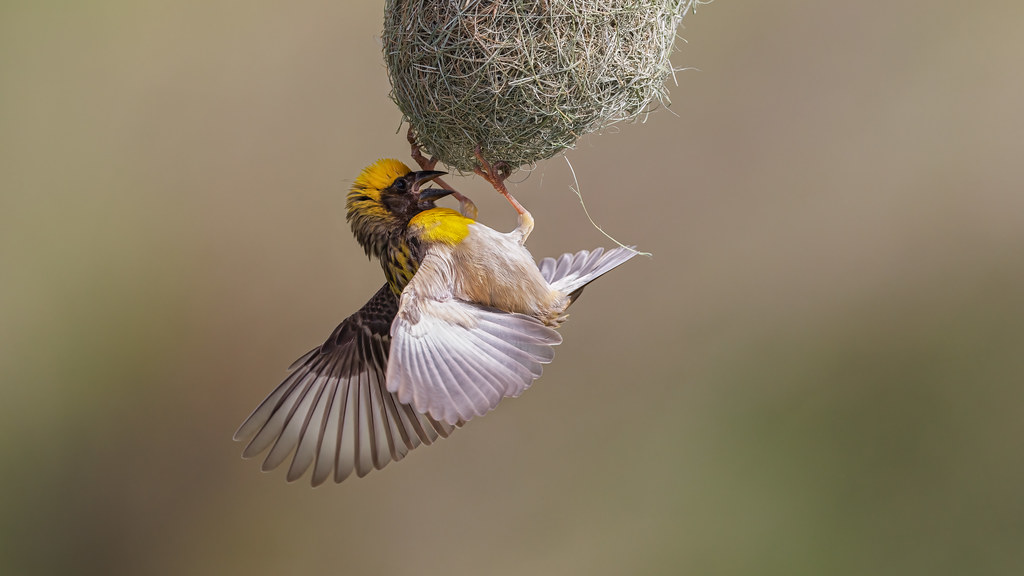
Despite their architectural ingenuity, Baya Weavers face growing challenges in the modern environment that test their adaptive capabilities. Habitat loss represents the most significant threat, as wetlands and grasslands that provide both nesting sites and construction materials disappear due to agricultural expansion and urbanization. Climate change poses additional challenges, with altered rainfall patterns affecting both the availability of building materials and the structural demands on nests. Encouragingly, these resourceful birds have demonstrated remarkable adaptability in some urban and suburban environments, incorporating artificial materials like plastic strings and synthetic fibers into their nests when natural materials are scarce. Conservation efforts focused on preserving riparian zones and traditional agricultural landscapes have shown promise in maintaining viable weaver populations, with some communities establishing protected areas specifically to preserve these avian architects and their remarkable creations.
Scientific Research and Biomimicry Applications
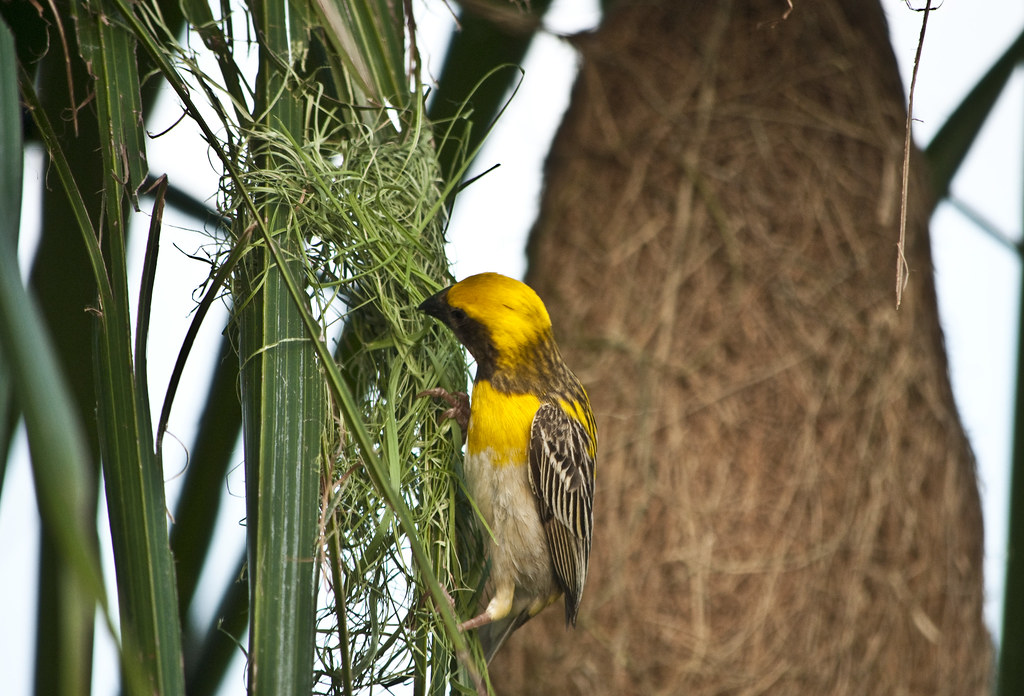
The extraordinary engineering achievements of Baya Weavers have increasingly attracted scientific attention, with researchers from fields ranging from ornithology to materials science studying these structures for insights applicable to human technology. Detailed analysis of nest mechanics has revealed sophisticated use of tension and compression forces that could inform lightweight architectural designs. The birds’ weaving techniques have inspired developments in textile manufacturing, particularly in creating strong yet flexible fabrics with minimal material usage. Perhaps most intriguingly, robotics engineers have studied the sequential construction methods of these birds to develop algorithms for automated building systems that can create complex structures without centralized planning. This emerging field of “avian-inspired architecture” represents a fascinating convergence of biology and engineering, where the instinctive genius of a small songbird may help solve human design challenges through biomimetic applications.
A Testament to Natural Engineering
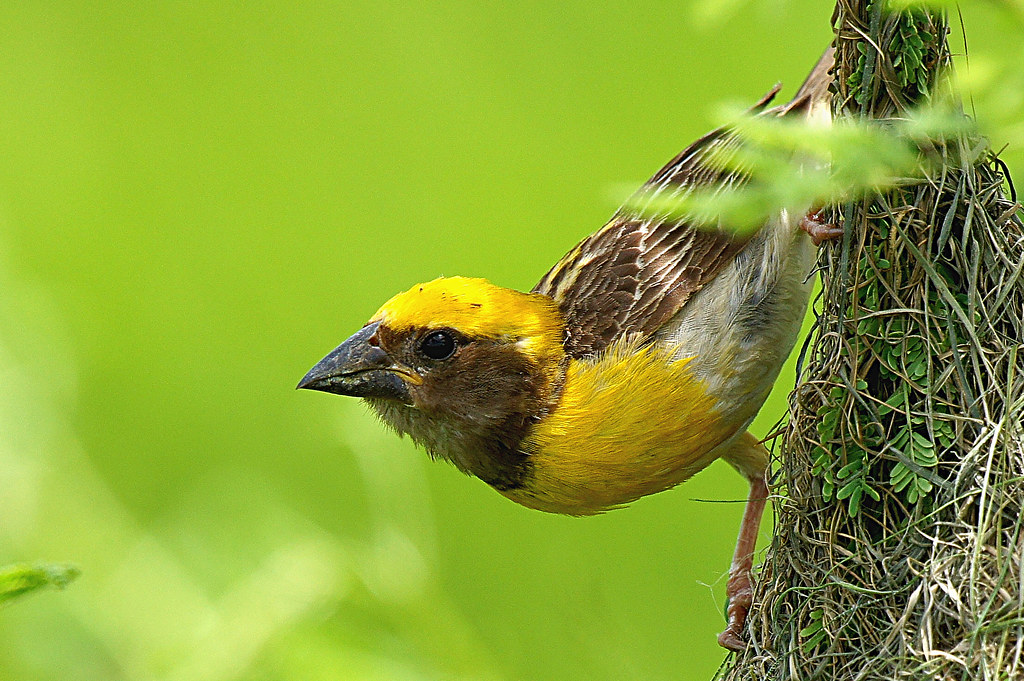
The gravity-defying nests of the Baya Weaver stand as remarkable testaments to the engineering capabilities that have evolved in the natural world. These small songbirds, with no formal training or understanding of physical principles, consistently create structures that would challenge human architects working without modern tools or materials. Each nest represents thousands of individual decisions about material selection, placement, and structural reinforcement, resulting in a home perfectly adapted to the challenges of their environment. The next time you encounter a bird’s nest, particularly one of these pendulous masterpieces, take a moment to appreciate the extraordinary combination of instinct, learning, and evolutionary adaptation that makes such architectural achievements possible. In the delicate weaving of a Baya Weaver’s nest, we find a powerful reminder that engineering excellence has existed in nature long before humans began building their first shelters.
